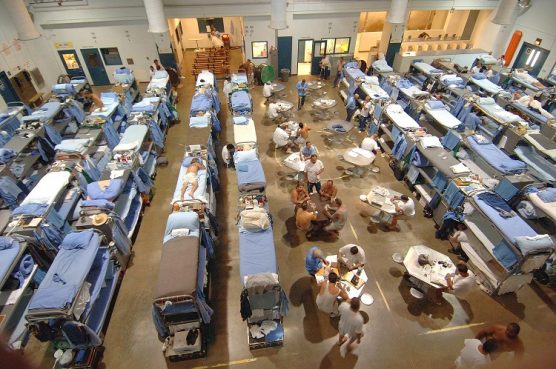By Martin Mascias Jr.
A voter-approved ballot measure aimed at reducing California’s prison population and ending racial disparities in the war on drugs has produced most of the cost-saving, equity-focused results it promised, with some exceptions, according to a study published Thursday.
The state’s Proposition 47 measure, which reclassified non-violent crimes – such as drug possession and property crimes – from felonies to misdemeanors, reduced the state’s prison and jail populations and resulted in fewer drug arrests, according to the study by researchers at the University of California in San Francisco.
Other crimes that fell under the measure’s authority included forgery, fraud, shoplifting, petty theft and possession of small quantities of drugs, including heroin and cocaine.
In the first year after the law took effect, researchers calculated there were 117,126 fewer felony arrests across the state than there would have been without the new law.
“Police made fewer arrests in the Proposition 47 category, but they did not start increasing arrests in the sale category,” UCSF researcher and report author Alyssa Mooney said in a statement. “There was no shift by police to ramp up on those arrests.”
The measure only reduced one class of felonies — drug possession — to misdemeanors. It did not address more severe felony offenses, like sale, for which blacks are more commonly charged.
“As a result, Proposition 47 only reduced felony drug arrest rates by 66.1 percent for Blacks,” the report said. “Whereas for Whites and Latinos, the percentage decreases were larger, at 75.9 percent and 73.7 percent, respectively.”
One unforeseen consequence of the reclassification is that relative disparity between blacks and whites – which compares the rates at which blacks and whites were getting arrested on felony drug charges – actually increased slightly.
Still, Mooney said, the more important number in measuring public health effects of racial disparities in arrest rates was the absolute disparity, or the difference between the total number of felony arrests per 100,000 people in each group.
“The absolute disparity—given the size of the population, how many fewer people are getting felony arrests—matters more when we want to understand the population impact of the new law,” she said.
The ballot referendum – passed by voters in November 2014 – was at the “leading edge of a national movement to reduce incarceration rates,” the study said.
At the time that it was up for debate, the initiative had the support of Democratic Lt. Gov., and current gubernatorial candidate, Gavin Newsom, Republican former Speaker of the House Newt Gingrich and several prominent labor unions.
It was opposed by Democratic U.S. Senator Dianne Feinstein, the California State Sheriffs Association and the state’s Republican Party, among other groups.
City officials across the state have tried to link the measure to a spike in homeless people with mental illness as individuals left the prison system and attempted to reenter society and the workforce.
With federal cuts shuttering state mental health hospitals and prisons overcrowded, thousands of people were forced onto the streets to wait for treatment beds to open up.
The study found that Proposition 47 reduced felony drug arrests by nearly 75 percent across the state. One of the immediate effects of the measure was to ameliorate the inequality in how black and white residents were arrested on drug charges.
“The difference between black and white residents in felony drug arrests decreased after the measure took effect, dropping from 81 per 100,000 residents to 44, and continued to decline over the course of the year,” the study said.
The initiative also extended re-sentencing guidelines to individuals serving a prison sentence for any of the offenses the initiative reduced to misdemeanors.
At the time Proposition 47 was passed, 10,000 inmates were eligible for resentencing, according to Lenore Anderson of Californians for Safety and Justice.
In Los Angeles, which has the country’s largest jail system, the inmate population fell by 17 percent, or 3,200 inmates, after the measure took effect.
The study by researchers found that while jail population numbers fell, estimated state savings grew by millions.
A February 2015 report from the state’s Legislative Analyst’s Office estimated that state savings would range from $100 million to $200 million beginning in the 2016-17 fiscal year.
The measure has faced multiple court challenges over the years and has been blamed for occurrences of crimes by repeat offenders.
In November 2017, the state Supreme Court ruled in People v. Page that individuals convicted of felonies for stealing vehicles valued at $950 or less could have their convictions reduced from felonies to misdemeanors under Proposition 47.
Both the San Bernardino Superior Court and Fourth District Court of Appeal had argued that Timothy Page could not seek to reduce his sentence under Proposition 47.
The measure also distributed money that the state saved through decarceration – estimated between $150 million to $250 million annually – to the Department of Education, the Victim Compensation and Government Claims Board, and the Board of State and Community Correction.
Mooney said that efforts like Proposition 47 are an “effective way to decrease the disparity in drug arrests between blacks and whites.”
“The collateral consequences of felony drug convictions are severe—affecting everything from whether someone can get a job to their ability to get housing and student aid,” Mooney said. “So, alleviating these disparities could help narrow the significant disparities we see between groups in important health and social outcomes.”
Like this:
Like Loading...
Related





 Tweet This
Tweet This Facebook
Facebook Digg This
Digg This Bookmark
Bookmark Stumble
Stumble RSS
RSS


























REAL NAMES ONLY: All posters must use their real individual or business name. This applies equally to Twitter account holders who use a nickname.
4 Comments
And what is the rate of increase in property crime for the same period of time?
And what is the rate (%) of misdemeanor “Notice to Appear”, for the same period, that never show up to court for each of these now misdemeanor offenses
We had a drug addict shooting heroin and smoking meth in his car in front of our house for about 2 months straight.
He would be arrested and then released within 2 hours only to return.
This law is INSANITY and needs to be repealed ASAP!
Thus crime and homeless will continue to increase; jeopardizing everyone’s safety! Tent city on Lyons Ave here we come!
Repeal this law immediately !!
Decriminalizing crime is NOT CRIME REDUCTION.
Now the criminals are more emboldened!